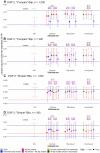The optimal dynamic treatment rule superlearner: considerations, performance, and application to criminal justice interventions
- PMID: 35708222
- PMCID: PMC10238854
- DOI: 10.1515/ijb-2020-0127
The optimal dynamic treatment rule superlearner: considerations, performance, and application to criminal justice interventions
Abstract
The optimal dynamic treatment rule (ODTR) framework offers an approach for understanding which kinds of patients respond best to specific treatments - in other words, treatment effect heterogeneity. Recently, there has been a proliferation of methods for estimating the ODTR. One such method is an extension of the SuperLearner algorithm - an ensemble method to optimally combine candidate algorithms extensively used in prediction problems - to ODTRs. Following the ``causal roadmap," we causally and statistically define the ODTR and provide an introduction to estimating it using the ODTR SuperLearner. Additionally, we highlight practical choices when implementing the algorithm, including choice of candidate algorithms, metalearners to combine the candidates, and risk functions to select the best combination of algorithms. Using simulations, we illustrate how estimating the ODTR using this SuperLearner approach can uncover treatment effect heterogeneity more effectively than traditional approaches based on fitting a parametric regression of the outcome on the treatment, covariates and treatment-covariate interactions. We investigate the implications of choices in implementing an ODTR SuperLearner at various sample sizes. Our results show the advantages of: (1) including a combination of both flexible machine learning algorithms and simple parametric estimators in the library of candidate algorithms; (2) using an ensemble metalearner to combine candidates rather than selecting only the best-performing candidate; (3) using the mean outcome under the rule as a risk function. Finally, we apply the ODTR SuperLearner to the ``Interventions" study, an ongoing randomized controlled trial, to identify which justice-involved adults with mental illness benefit most from cognitive behavioral therapy to reduce criminal re-offending.
Keywords: causal roadmap; heterogeneous treatment effects; optimal dynamic treatment rules; precision health; superlearner.
© 2022 Walter de Gruyter GmbH, Berlin/Boston.
Figures



Similar articles
-
Estimators for the value of the optimal dynamic treatment rule with application to criminal justice interventions.Int J Biostat. 2022 Jun 6;19(1):239-259. doi: 10.1515/ijb-2020-0128. eCollection 2023 May 1. Int J Biostat. 2022. PMID: 35659857 Free PMC article.
-
Benchmarking clinical risk prediction algorithms with ensemble machine learning: An illustration of the superlearner algorithm for the non-invasive diagnosis of liver fibrosis in non-alcoholic fatty liver disease.medRxiv [Preprint]. 2023 Aug 4:2023.08.02.23293569. doi: 10.1101/2023.08.02.23293569. medRxiv. 2023. Update in: Hepatology. 2024 Nov 1;80(5):1184-1195. doi: 10.1097/HEP.0000000000000908. PMID: 37577485 Free PMC article. Updated. Preprint.
-
Applied machine learning to identify differential risk groups underlying externalizing and internalizing problem behaviors trajectories: A case study using a cohort of Asian American children.PLoS One. 2023 Mar 3;18(3):e0282235. doi: 10.1371/journal.pone.0282235. eCollection 2023. PLoS One. 2023. PMID: 36867610 Free PMC article.
-
Developing Methods to Predict Health Outcomes in Trauma Patients [Internet].Washington (DC): Patient-Centered Outcomes Research Institute (PCORI); 2020 Jan. Washington (DC): Patient-Centered Outcomes Research Institute (PCORI); 2020 Jan. PMID: 39008649 Free Books & Documents. Review.
-
Impact of summer programmes on the outcomes of disadvantaged or 'at risk' young people: A systematic review.Campbell Syst Rev. 2024 Jun 13;20(2):e1406. doi: 10.1002/cl2.1406. eCollection 2024 Jun. Campbell Syst Rev. 2024. PMID: 38873396 Free PMC article. Review.
Cited by
-
Adapt for Adolescents: Protocol for a sequential multiple assignment randomized trial to improve retention and viral suppression among adolescents and young adults living with HIV in Kenya.Contemp Clin Trials. 2023 Apr;127:107123. doi: 10.1016/j.cct.2023.107123. Epub 2023 Feb 20. Contemp Clin Trials. 2023. PMID: 36813086 Free PMC article.
-
Learning optimal dynamic treatment regimes from longitudinal data.Am J Epidemiol. 2024 Dec 2;193(12):1768-1775. doi: 10.1093/aje/kwae122. Am J Epidemiol. 2024. PMID: 38879744 Free PMC article.
-
Machine learning for estimating and comparing clinical rules for treating diarrheal illness with antibiotics.medRxiv [Preprint]. 2025 Jan 12:2025.01.10.25320357. doi: 10.1101/2025.01.10.25320357. medRxiv. 2025. PMID: 39830249 Free PMC article. Preprint.
-
Estimators for the value of the optimal dynamic treatment rule with application to criminal justice interventions.Int J Biostat. 2022 Jun 6;19(1):239-259. doi: 10.1515/ijb-2020-0128. eCollection 2023 May 1. Int J Biostat. 2022. PMID: 35659857 Free PMC article.
References
-
- Skeem JL, Manchak S, Peterson JK. Correctional policy for offenders with mental illness: creating a new paradigm for recidivism reduction. Law Hum Behav. 2011;35:110–26. - PubMed
-
- Skeem JL, Winter E, Kennealy PJ, Louden JE, Tatar JR. Offenders with mental illness have criminogenic needs, too: toward recidivism reduction. Law Hum Behav. 2014;38:212–24. - PubMed
